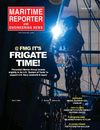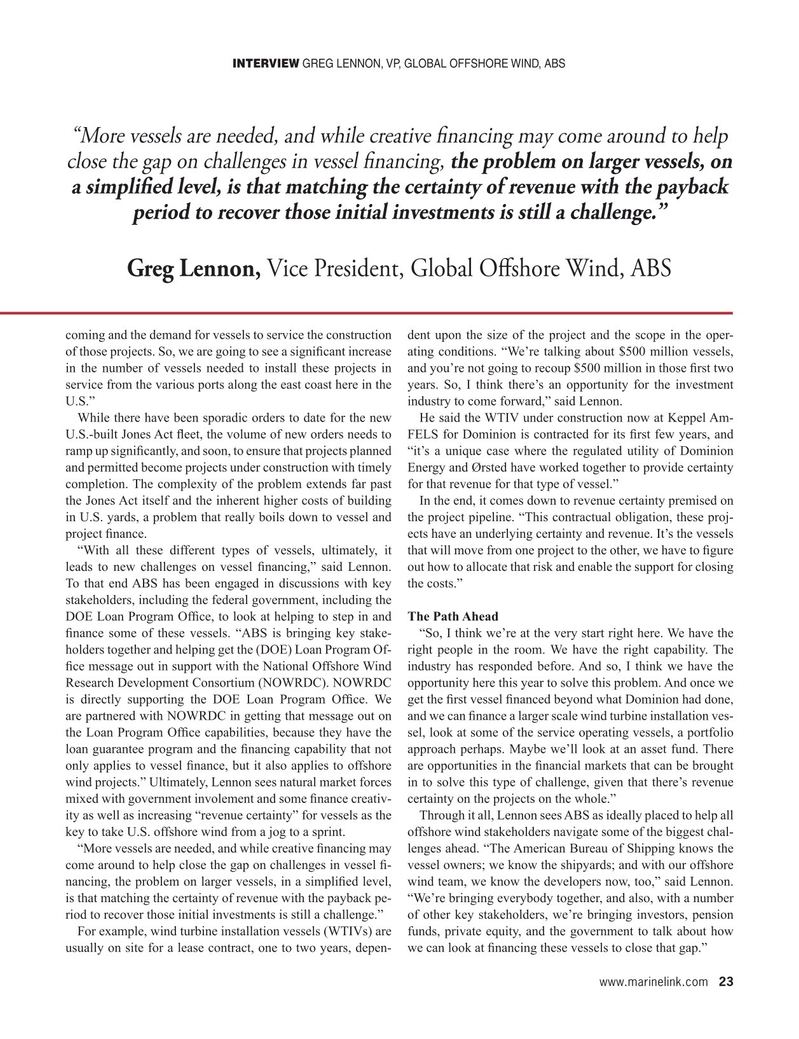
Page 23: of Maritime Reporter Magazine (February 2022)
Government Shipbuilding
Read this page in Pdf, Flash or Html5 edition of February 2022 Maritime Reporter Magazine
INTERVIEW GREG LENNON, VP, GLOBAL OFFSHORE WIND, ABS “More vessels are needed, and while creative f nancing may come around to help close the gap on challenges in vessel f nancing, the problem on larger vessels, on a simplif ed level, is that matching the certainty of revenue with the payback period to recover those initial investments is still a challenge.”
Greg Lennon, Vice President, Global Of shore Wind, ABS coming and the demand for vessels to service the construction dent upon the size of the project and the scope in the oper- of those projects. So, we are going to see a signi? cant increase ating conditions. “We’re talking about $500 million vessels, in the number of vessels needed to install these projects in and you’re not going to recoup $500 million in those ? rst two service from the various ports along the east coast here in the years. So, I think there’s an opportunity for the investment
U.S.” industry to come forward,” said Lennon.
While there have been sporadic orders to date for the new He said the WTIV under construction now at Keppel Am-
U.S.-built Jones Act ? eet, the volume of new orders needs to FELS for Dominion is contracted for its ? rst few years, and ramp up signi? cantly, and soon, to ensure that projects planned “it’s a unique case where the regulated utility of Dominion and permitted become projects under construction with timely Energy and Ørsted have worked together to provide certainty completion. The complexity of the problem extends far past for that revenue for that type of vessel.” the Jones Act itself and the inherent higher costs of building In the end, it comes down to revenue certainty premised on in U.S. yards, a problem that really boils down to vessel and the project pipeline. “This contractual obligation, these proj- project ? nance. ects have an underlying certainty and revenue. It’s the vessels “With all these different types of vessels, ultimately, it that will move from one project to the other, we have to ? gure leads to new challenges on vessel ? nancing,” said Lennon. out how to allocate that risk and enable the support for closing
To that end ABS has been engaged in discussions with key the costs.” stakeholders, including the federal government, including the
DOE Loan Program Of? ce, to look at helping to step in and The Path Ahead ? nance some of these vessels. “ABS is bringing key stake- “So, I think we’re at the very start right here. We have the holders together and helping get the (DOE) Loan Program Of- right people in the room. We have the right capability. The ? ce message out in support with the National Offshore Wind industry has responded before. And so, I think we have the
Research Development Consortium (NOWRDC). NOWRDC opportunity here this year to solve this problem. And once we is directly supporting the DOE Loan Program Of? ce. We get the ? rst vessel ? nanced beyond what Dominion had done, are partnered with NOWRDC in getting that message out on and we can ? nance a larger scale wind turbine installation ves- the Loan Program Of? ce capabilities, because they have the sel, look at some of the service operating vessels, a portfolio loan guarantee program and the ? nancing capability that not approach perhaps. Maybe we’ll look at an asset fund. There only applies to vessel ? nance, but it also applies to offshore are opportunities in the ? nancial markets that can be brought wind projects.” Ultimately, Lennon sees natural market forces in to solve this type of challenge, given that there’s revenue mixed with government involement and some ? nance creativ- certainty on the projects on the whole.” ity as well as increasing “revenue certainty” for vessels as the Through it all, Lennon sees ABS as ideally placed to help all key to take U.S. offshore wind from a jog to a sprint. offshore wind stakeholders navigate some of the biggest chal- “More vessels are needed, and while creative ? nancing may lenges ahead. “The American Bureau of Shipping knows the come around to help close the gap on challenges in vessel ? - vessel owners; we know the shipyards; and with our offshore nancing, the problem on larger vessels, in a simpli? ed level, wind team, we know the developers now, too,” said Lennon. is that matching the certainty of revenue with the payback pe- “We’re bringing everybody together, and also, with a number riod to recover those initial investments is still a challenge.” of other key stakeholders, we’re bringing investors, pension
For example, wind turbine installation vessels (WTIVs) are funds, private equity, and the government to talk about how usually on site for a lease contract, one to two years, depen- we can look at ? nancing these vessels to close that gap.” www.marinelink.com 23
MR #2 (18-33).indd 23 2/4/2022 9:26:31 AM

 22
22

 24
24
